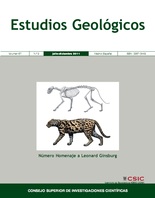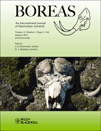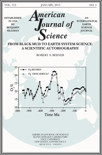
Quaternary Science Advances
Scope & Guideline
Transforming Knowledge in Quaternary Science and Beyond
Introduction
Aims and Scopes
- Paleoenvironmental Reconstruction:
The journal emphasizes the reconstruction of past environments using various proxies, including sedimentary records, geochemical analyses, and paleoecological data to understand climate changes and human impacts. - Geospatial and Remote Sensing Applications:
Quaternary Science Advances frequently publishes studies that utilize advanced geospatial techniques and remote sensing for analyzing landforms, assessing environmental risks, and mapping hazards like landslides and floods. - Climate Change Dynamics:
Research in this journal often explores the interplay between climate change and geological processes, focusing on how historical climatic events have shaped current environmental conditions. - Geological and Tectonic Studies:
The journal includes significant contributions on geological formations and tectonic activities, particularly in relation to Quaternary landscapes and their evolution over time. - Human-Environment Interactions:
A core area of focus is the investigation of human interactions with the environment throughout the Quaternary period, including subsistence strategies and the impact of anthropogenic activities on ecosystems. - Sedimentology and Stratigraphy:
Studies on sediment characteristics and stratigraphic sequences provide insights into depositional environments and geological history, contributing to a better understanding of past climate and environmental changes.
Trending and Emerging
- Landslide and Natural Hazard Assessment:
There is a significant increase in studies focusing on landslide susceptibility and risk assessment using geospatial technologies, reflecting a broader concern for natural hazards in the context of climate change and urbanization. - Integrated Multi-proxy Analyses:
Research employing integrated multi-proxy approaches for environmental reconstruction is trending, as it provides a comprehensive understanding of complex interactions between ecological and geological systems. - Climate Change Impacts and Adaptation Strategies:
An emerging theme is the investigation of climate change impacts on ecosystems, with a focus on adaptation strategies, particularly in vulnerable regions such as the Himalayas and coastal areas. - Geochemical and Isotopic Studies:
The use of geochemical and isotopic analyses to study past climate conditions and human impacts is on the rise, reflecting advancements in analytical techniques and their applicability to Quaternary research. - Technological Innovations in Research Methodologies:
There is a growing trend towards utilizing advanced technologies, such as machine learning and remote sensing, for data analysis and environmental modeling, indicating a shift towards more data-driven approaches in Quaternary studies.
Declining or Waning
- Traditional Paleoanthropology:
Research specifically focused on paleoanthropology is becoming less prominent, possibly due to a shift towards more interdisciplinary approaches that integrate archeological and ecological perspectives rather than solely focusing on human evolution. - Static Climate Models:
Studies relying on static climate models without incorporating dynamic interactions or feedback mechanisms are decreasing, as the field moves towards more complex, integrated modeling approaches that account for various influencing factors. - Regional Studies with Limited Scope:
There is a noticeable decline in research that focuses narrowly on specific geographic regions without broader implications or comparisons, as the journal emphasizes more integrative studies that connect findings across different areas.
Similar Journals

Swiss Journal of Geosciences
Connecting Researchers to the Heart of Earth ScienceSwiss Journal of Geosciences is a prestigious academic journal dedicated to advancing the field of geosciences, published by SPRINGER INTERNATIONAL PUBLISHING AG. Since its inception in 2007, the journal has established itself as a leading platform for disseminating high-quality research findings in various domains related to Earth and planetary sciences, achieving a notable Q1 ranking in Geology as of 2023. With a solid reputation reflected in its Scopus ranking of Rank #72/321, the journal stands in the 77th percentile within its category. Based in Switzerland, the Swiss Journal of Geosciences embraces an open access model, making it easier for researchers, professionals, and students worldwide to access vital geological research without barriers. The journal’s objectives include promoting interdisciplinary research and fostering insights that address both fundamental and applied geoscientific problems, ensuring it remains a crucial resource for those seeking to understand our planet’s dynamics. Engage with pioneering research and contribute to the vibrant community of geoscientists by exploring the impactful articles published within its pages.

ESTUDIOS GEOLOGICOS-MADRID
Connecting Researchers with Earth’s Secrets Since 1976.ESTUDIOS GEOLOGICOS-MADRID is a prominent journal in the field of geology, published by the esteemed Consejo Superior de Investigaciones Científicas (CSIC) in Spain. Established in 1976, this Open Access journal has been a vital resource for researchers and professionals since its inception. With an impact factor reflecting its contribution to the Earth and Planetary Sciences community, ESTUDIOS GEOLOGICOS-MADRID currently holds a Q3 category ranking in Geology as of 2023, showcasing its relevance and quality within the discipline. The journal publishes a diverse array of geological studies, ensuring wide-reaching access to significant research findings, thereby promoting collaboration and knowledge sharing. Established as a platform for both foundational research and applied geology, this journal fosters academic growth and contributes to understanding the Earth’s processes. Researchers, professionals, and students are encouraged to explore its extensive archive, which includes publications from 1976 to the present. For more information, visit the journal's editorial office at Editorial CSIC, C/VITRUVIO 8, 28006 MADRID, SPAIN.

BOREAS
Pioneering Research in Archaeology and EcologyBOREAS is a prestigious academic journal published by WILEY, dedicated to advancing knowledge across the fields of Archaeology, Ecology, Evolution, Behavior, Systematics, and Geology. With a commendable track record since its inception in 1972, BOREAS has consistently contributed to the scholarly landscape, currently holding a distinguished position in Q1 across multiple categories, including a ranking of #8 in Archaeology and a solid percentile rank in Ecology and Geology. This high-impact journal fosters the dissemination of groundbreaking research, further establishing itself as a vital resource for researchers, professionals, and students alike. While access options are limited to subscription-based, the quality and significance of research published in BOREAS make it an essential addition to any academic library, ensuring that studies conducted in these pivotal fields reach a global audience. With a commitment to excellence and innovation, BOREAS continues to drive forward the frontiers of knowledge and understanding in Earth and planetary sciences.

AMERICAN JOURNAL OF SCIENCE
Uncovering the Secrets of Our PlanetThe American Journal of Science, published by the esteemed Amer Journal Science, stands as a leading platform for groundbreaking research in the field of Earth and Planetary Sciences. With an impressive impact factor and distinguished Scopus rank 34/195 in its category, the journal occupies a prestigious position in the academic community, reflecting its high-quality and influential contributions to scientific knowledge. The journal’s objective is to disseminate original research, comprehensive reviews, and critical discussions that advance our understanding of geological processes and planetary phenomena, supporting scholars and practitioners in their pursuit of knowledge. Despite its traditional publication structure, viewers can explore its rich repository of works dating from 1945 to present, offering a wealth of insights into the dynamic Earth sciences. The journal remains a vital resource for researchers, professionals, and students eager to engage with the latest scientific findings and foster further innovation in the field.

GEOSCIENCES JOURNAL
Pioneering Insights into Earth's Complex Systems.Welcome to the GEOSCIENCES JOURNAL, a pivotal publication in the fields of Earth and Planetary Sciences and Environmental Science, proudly presented by the Geological Society of Korea. Established in 1997, this journal has become a prominent platform for researchers, professionals, and students, offering a rich collection of peer-reviewed articles that explore a diverse array of geoscientific topics. With an impressive Q2 ranking in both Earth and Planetary Sciences and Environmental Science categories for 2023, it stands as an essential resource in the academic community. Though it operates under a traditional subscription model, GEOSCIENCES JOURNAL remains dedicated to advancing knowledge through rigorous research. Addressed from its headquarters in Seoul, South Korea, the journal aims to foster a deeper understanding of geosciences, encouraging innovation and collaboration in tackling today’s environmental challenges.

Boletim Paranaense de Geociencias
Connecting Local Discoveries to Global NarrativesBoletim Paranaense de Geociencias, published by UNIV FED PARANA, EDITORA, serves as a vital platform for advancing knowledge in the field of Earth and Planetary Sciences, contributing significantly to discussions surrounding geological research and discovery. With an ISSN of 0067-964X, this esteemed journal primarily features studies that reflect regional geological contexts while also addressing wider planetary science issues. Although it currently holds a Q4 category quartile ranking and a 15th percentile in the Scopus rankings within its field, the journal remains committed to disseminating valuable insights and fostering academic discourse. This is of particular significance as it tirelessly updates its publication scope, aiming to include contributions from diverse geological studies both regionally and globally. While it operates on a printed basis, researchers and students alike will find the Boletim’s progressive discussions critical for understanding the dynamic processes shaping our planet.

Frontiers of Earth Science
Exploring the Depths of Earth and BeyondFrontiers of Earth Science is a prominent academic journal in the field of Earth and Planetary Sciences, published by Springer. With an ISSN of 2095-0195 and an E-ISSN of 2095-0209, this journal serves as a significant platform for researchers and professionals to disseminate their findings from 2007 to 2024. It is recognized for its impactful contributions within the category of Earth and Planetary Sciences, boasting a respected Q2 ranking in 2023. With a Scopus ranking of 64 out of 195, placing it in the 67th percentile, Frontiers of Earth Science continues to drive academic dialogue and innovation. The journal is dedicated to exploring a diverse range of topics, including geology, meteorology, and environmental science, and amplifying the understanding of Earth systems through rigorous research. Located in New York, USA, this journal embraces an Open Access model, ensuring that groundbreaking research is readily available to the global scientific community, thereby enhancing its accessibility and impact.

Cuaternario y Geomorfologia
Pioneering Insights in Geography and GeologyCuaternario y Geomorfologia is a distinguished journal published by the Spanish Quaternary Research Association, focusing on the interdisciplinary study of Quaternary research, geomorphology, and related fields. With its ISSN 0214-1744 and a publication history spanning from 2012 to 2024, the journal serves as a critical platform for researchers and practitioners in geography, geology, and paleontology. Although its current Scopus rankings place it in the lower quartiles across various categories, being Q4 in Earth-Surface Processes, Geography, Planning and Development, Geology, and Paleontology, Cuaternario y Geomorfologia continues to push boundaries within its sphere, aiming to foster a deeper understanding of Earth sciences. Situated in Madrid, Spain, the journal's commitment to sharing groundbreaking research without access barriers enhances its value for academics, offering insights that drive forward the fields of Quaternary studies and beyond. Researchers, professionals, and students alike will find a rich repository of knowledge within its pages, making it an essential resource for current and aspiring experts in the discipline.

Geologos
Connecting Scholars Worldwide to the Heart of Earth ScienceGeologos is a peer-reviewed journal dedicated to advancing knowledge in the field of Earth and Planetary Sciences. Published by SCIENDO, this Open Access journal has been facilitating unrestricted access to research findings since 2009, ensuring that scholars, professionals, and students can engage with up-to-date scientific discourse without barriers. With an ISSN of 1426-8981 and an E-ISSN of 2080-6574, Geologos is indexed in Scopus, where it currently holds a rank of #111 out of 195 in the General Earth and Planetary Sciences category, reflecting its commendable impact within the discipline. Based in Poland, the journal embraces contributions from international authors, promoting a diverse and inclusive dialogue on topics ranging from geological phenomena to planetary processes. As a Q3 journal in the Earth and Planetary Sciences category, Geologos is committed to enhancing the understanding and appreciation of the Earth's systems, making it an essential resource for those engaged in research and practice within this dynamic field.

DOKLADY EARTH SCIENCES
Connecting Researchers to Contemporary Earth ChallengesDOKLADY EARTH SCIENCES is a reputable journal published by MAIK NAUKA/INTERPERIODICA/SPRINGER, focusing on the dynamic field of Earth and Planetary Sciences. With an ISSN of 1028-334X and E-ISSN 1531-8354, this journal offers a platform for researchers to disseminate their findings and insights that contribute to our understanding of Earth systems over a continuous publishing span from 1998 to 2024. It currently holds a Q3 quartile ranking in the Earth and Planetary Sciences category, reflecting an emerging yet significant impact within its field, evidenced by its Scopus ranks where it stands at 123rd in general Earth sciences and 113th in miscellaneous Earth sciences. DOKLADY EARTH SCIENCES aims to bridge research gaps and foster collaboration among a diverse audience including researchers, professionals, and students committed to advancing knowledge in geoscience. The journal stands as a vital resource for those seeking to explore contemporary challenges and innovations within the realm of Earth sciences.